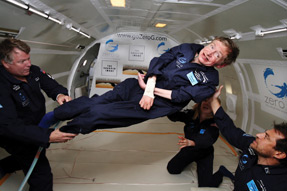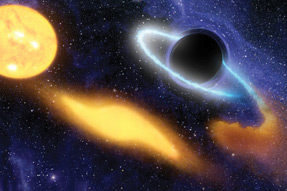Life
Defying Gravity

We know the least about the first force we mastered.
On a recent space shuttle mission, as a symbolic tribute to the father of gravity, NASA astronaut Piers Sellers carried along with him a chip of wood from Isaac Newton’s legendary apple tree that helped Newton formulate the law of gravity. Whatever the real story connected to this tree, one thing is certain — the force that attracts the apple to the earth is the same force that keeps the planets in their orbit, stars in the galaxies, and galaxies in the universe. Without this cosmic glue, there would be no stars, planets or even life. Newton identified the force and Einstein tamed it, yet this very first force of nature harbors secrets that we may never know. In a post-Einsteinian world, the attempts to untangle this force have introduced some inconceivable effects that shatter many of our deeply held convictions.
Gravity is the first force we understood quantitatively, thanks to Newton’s Law of gravity. Even our rocket science is based on this simple and powerful law of nature expressed mathematically by Newton. Though Newtonian equations offer functional insight into this force, Newton wasn’t sure — rather he didn’t bother — about how gravity worked. It took another 200 years and the genius of Einstein to unlock that secret. For him gravity was not a force due to mass as Newton envisaged, but a property of the geometry of space-time. According to Einstein, massive objects bend the surrounding space-time to create the effect of gravity, which is a huge transition from the Newtonian worldview. The seemingly familiar force of gravity that is so integrated into our psyche can appear in a totally unfamiliar ways. Black holes are examples of how gravity can manifest itself in its extreme. The massive stars that collapse to become black holes defy any conventional explanations available in science. The gravity in black holes is so powerful that even light doesn’t escape from this weird region of space. In fact, the indirect detection of black holes becomes possible only due to the immense gravitational effect on the surrounding stars. Consequently, this gravitational force has effect on time as well, as predicted by Einstein’s theory. Time must slowdown in such a strong gravitational field. In other words, if we could observe an object falling into a black hole, it would be frozen in time — an ultimate slow motion. The pioneer anomaly is another example of our failure to comprehend gravity. The Pioneer spacecrafts launched in early 1970s are now billions of miles from earth, beyond even our solar system. NASA discovered that an inexplicable force appears to be acting on the probes as they head away from the Sun. They seem to be moving differently from how they should have been. Scientists have yet to determine the cause of this violation of our known laws of gravity.
One of the foremost challenges facing 21st century physics is to reconcile the theory of relativity, which explains large scale gravity, to quantum mechanics, the world of fundamental particles. Scientists agree that four fundamental forces govern nature — namely, gravity, electromagnetic force, strong and weak forces. Quantum mechanics asserts that there is a particle associated with each of these forces. As a familiar example, light, an electromagnetic force, is carried by photon — the fundamental particle that governs electromagnetic force. So far, the carrying particle for gravitational force, namely, graviton has never been found though theoretical models predict its existence. Einstein’s theory predicts the possible existence of gravitational waves similar to the ripples in a pond that travel from their point of their origin. Thus gravitational waves must originate as ripples in the fabric of the space-time, as a result of cosmic events such as a star collapse or galaxy collisions. Unlike electromagnetic waves, these gravity waves are so delicate and they need the most sensitive instruments to detect them. The gravity wave detection is the objectives of LIGO (Laser Interferometer Gravitational-Wave Observatory). Two of the biggest such interferometers in the United States — one in Hanford, Wash., and the other in Livingston, La. —are collectively called LIGO. These systems are sensitive enough to detect the ripples in the space-time fabric caused by cosmic events, such as supernova explosions, and transmitted by gravity waves. These waves carry the information of events, such as the explosion and collision of stars or even the origin of our universe. It was estimated that by 2010, direct detection of gravity waves will be possible, but so far there are no such reports of confirmation. A recent result from German-British gravitational detector in Hannover, Germany, offered, by some interpretations, a holographic picture of the universe. Every physicist agrees that our universe is an interplay between matter and energy and Einstein’s famous equation relates the two through E=mc2. But, what if our universe is just an information exchanging network — an archetype proposed earlier by the physicist David Bohm. A hologram contains all the information about a 3D image encoded in a 2D object only to be revealed under the right conditions. Every part of a hologram contains all the information possessed by the whole. What we experience here might itself be a holographic projection of the information of the processes that take place on a distant, 2D surface — a situation aptly described as “It from Bit.” In such a holographic universe, space and time are quantized, like pixels in a picture, and are no longer fundamental, let alone gravity. But this omnipresent force never stops straining our imaginations. From string theory to quantum gravity, the struggle to understand this force continues. Some theories even shake the foundation of its very existence.
Professor Erik Verlinde, a string theorist at the University of Amsterdam, in a recent paper “On the Origin of Gravity and Newton’s Laws of Motion,” argues that that the way science has been treating gravity is wrong. He asserts that there is something more basic and gravity is just an emergent phenomenon of those basic constituents: “Think of the universe as a box of scrabble letters. There is only one way to have the letters arranged to spell out the Gettysburg Address, but an astronomical number of ways to have them spell nonsense. Shake the box and it will tend toward nonsense, disorder will increase and information will be lost as the letters shuffle toward their most probable configurations. Could this be gravity?” Science demands that the theory of gravity respects the laws of quantum world. Matter at the fundamental level obeys the laws of quantum mechanics where the effect of gravity is small, and gravity follows the theory of relativity where the quantum effects are insignificant. But black holes teach us both effects are profound, as they are small in size but huge in mass. A complete comprehension of gravity will indeed be a huge leap in our scientific progress. As John Wheeler, the physicist who coined the term black hole explained: “All things physical are information-theoretic in origin and this is a participatory universe…. Observer participancy gives rise to information; and information gives rise to physics.” We have been taught that everything falls because of gravitational force. We see this force make and break the constituents of the universe. We know it gives and takes. It has a profound impact on our daily life. We owe our existence to this force. What we experience as our weight is the result of this force of attraction on our body by the planet earth. We are aware that our mechanical and biological clocks tick differently in different gravitational fields. We can shoot rockets by overcoming this force, yet our knowledge of gravity remains in its infancy. Gravity seems to be so plain and yet so complicated. |



